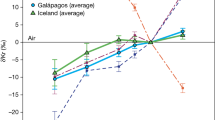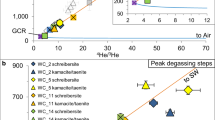Abstract
The depletion in moderately volatile elements in the Moon relative to Earth and comparison of the isotope compositions of the Moon and Earth have placed important constraints on models of lunar formation. A liquid–vapour protolunar disk from a high-energy giant impact has been proposed to explain some of these constraints. Here we present high-precision tin isotope data for lunar rocks, measured by double-spike MC-ICP-MS (multicollector inductively coupled plasma mass spectrometry). The lunar rocks are enriched in light tin isotopes compared to the Earth (Δ124/116SnMoon–Earth = −0.48 ± 0.15‰). On the basis of our data and constraints on tin speciation, we show that this tin isotope fractionation is inconsistent with volatile loss from a lunar magma ocean. Instead, we propose a scenario with vigorous mixing between the protolunar disk and the Earth in high-energy conditions during the impact, followed by liquid–vapour equilibration and phase separation at around 2,500 K while the disk was cooling. This scenario is consistent with the depletion in moderately volatile elements and isotope composition of the Moon.
This is a preview of subscription content, access via your institution
Access options
Access Nature and 54 other Nature Portfolio journals
Get Nature+, our best-value online-access subscription
$29.99 / 30 days
cancel any time
Subscribe to this journal
Receive 12 print issues and online access
$259.00 per year
only $21.58 per issue
Buy this article
- Purchase on Springer Link
- Instant access to full article PDF
Prices may be subject to local taxes which are calculated during checkout




Similar content being viewed by others
Data availability
All data that support the findings of this study are available in the manuscript or the supplementary materials.
References
Canup, R. M., Visscher, C., Salmon, J. & Fegley, B. Jr Lunar volatile depletion due to incomplete accretion within an impact-generated disk. Nat. Geosci. 8, 918–921 (2015).
Lock, S. J. et al. The origin of the moon within a terrestrial synestia. J. Geophys. Res. Planets 123, 910–951 (2018).
Charnoz, S. & Michaut, C. Evolution of the protolunar disk: dynamics, cooling timescale and implantation of volatiles onto the Earth. Icarus 260, 440–463 (2015).
Nakajima, M. & Stevenson, D. J. Investigation of the initial state of the Moon-forming disk: bridging SPH simulations and hydrostatic models. Icarus 233, 259–267 (2014).
Lock, S. J. et al. A new model for lunar origin: equilibration with Earth beyond the hot spin stability limit. 47th Lunar Planet. Sci. Conf. 47, abstr. 2881 (2016).
Young, E. D. et al. Oxygen isotopic evidence for vigorous mixing during the Moon-formation giant impact. Science 351, 493–496 (2016).
Herwartz, D., Pack, A., Friedrichs, B. & Bischoff, A. Identification of the giant impactor Theia in lunar rocks. Science 344, 1146–1150 (2014).
Touboul, M., Kleine, T., Bourdon, B., Palme, H. & Wieler, R. Late formation and prolonged differentiation of the Moon inferred from W isotopes in lunar metals. Nature 450, 1206–1209 (2007).
Kruijer, T. S. & Kleine, T. Tungsten isotopes and the origin of the Moon. Earth Planet. Sci. Lett. 475, 15–24 (2017).
Zhang, J., Dauphas, N., Davis, A. M., Leya, I. & Fedkin, A. The proto-Earth as a significant source of lunar material. Nat. Geosci. 5, 251–255 (2012).
Dauphas, N., Chen, J. & Papanastassiou, D. Testing Earth–Moon homogenization with calcium-48. 46th Lunar Planet. Sci. Conf. 46, abstr. 2436 (2015).
Schiller, M., Bizzarro, M. & Fernandes, V. A. Isotopic evolution of the protoplanetary disk and the building blocks of Earth and the Moon. Nature 555, 507–510 (2018).
Mougel, B., Moynier, F. & Göpel, C. Chromium isotopic homogeneity between the Moon, the Earth, and enstatite chondrites. Earth Planet. Sci. Lett. 481, 1–8 (2018).
Fitoussi, C. & Bourdon, B. Silicon isotope evidence against an enstatite chondrite Earth. Science 335, 1477–1480 (2012).
Fitoussi, C., Bourdon, B. & Wang, X. The building blocks of Earth and Mars: a close genetic link. Earth Planet. Sci. Lett. 434, 151–160 (2016).
Dauphas, N. & Schauble, E. Mass fractionation laws, mass-independent effects, and isotopic anomalies. Annu. Rev. Earth Planet. Sci. 44, 709–783 (2016).
Sedaghatpour, F., Teng, F. Z., Liu, Y., Sears, D. W. G. & Taylor, L. A. Magnesium isotopic composition of the Moon. Geochim. Cosmochim. Acta 120, 1–16 (2013).
Armytage, R. M. G., Georg, R. B., Williams, H. M. & Halliday, A. N. Silicon isotopes in lunar rocks: implications for the Moon’s formation and the early history of the Earth. Geochim. Cosmochim. Acta 77, 504–514 (2012).
Pringle, E. A. & Moynier, F. Rubidium isotopic composition of the Earth, meteorites, and the Moon: evidence for the origin of volatile loss during planetary accretion. Earth Planet. Sci. Lett. 473, 62–70 (2017).
Kato, C. & Moynier, F. Gallium isotopic evidence for extensive volatile loss from the Moon during its formation. Sci. Adv. 3, e1700571 (2017).
Wang, K. & Jacobsen, S. B. Potassium isotopic evidence for a high-energy giant impact origin of the Moon. Nature 538, 487–490 (2016).
Paniello, R. C., Day, J. M. D. & Moynier, F. Zinc isotopic evidence for the origin of the Moon. Nature 490, 376–379 (2012).
Kato, C., Moynier, F., Valdes, M. C., Dhaliwal, J. K. & Day, J. M. D. Extensive volatile loss during formation and differentiation of the Moon. Nat. Commun. 6, 7617 (2015).
Day, J. M. D., Moynier, F. & Shearer, C. K. Late-stage magmatic outgassing from a volatile-depleted Moon. Proc. Natl Acad. Sci. USA 36, 9547–9955 (2017).
Dhaliwal, J. K., Day, J. M. D. & Moynier, F. Volatile element loss during planetary magma ocean phases. Icarus 300, 249–260 (2018).
Wang, X., Fitoussi, C., Bourdon, B. & Amet, Q. A new method of Sn purification and isotopic determination with a double-spike technique for geological and cosmochemical samples. J. Anal. At. Spectrom. 32, 1009–1019 (2017).
Snyder, G. A., Taylor, L. A. & Neal, C. R. A chemical model for generating the sources of mare basalts: combined equilibrium and fractional crystallization of the lunar magmasphere. Geochim. Cosmochim. Acta 56, 3809–3823 (1992).
Wang, X., Amet, Q., Fitoussi, C. & Bourdon, B. Tin isotope fractionation during magmatic processes and the isotope composition of the bulk silicate Earth. Geochim. Cosmochim. Acta 228, 320–335 (2018).
Badullovich, N., Moynier, F., Creech, J., Teng, F.-Z. & Sossi, P. A. Tin isotopic fractionation during igneous differentiation and Earth’s mantle composition. Geochemical Perspect. Lett. 5, 24–28 (2017).
Taylor, G. J. & Wieczorek, M. A. Lunar bulk chemical composition: a post-Gravity Recovery and Interior Laboratory reassessment. Philos. Trans. R. Soc. A 372, 20130242 (2014).
Davis, A. M. & Richter, F. M. in Treatise on Geochemistry 2nd edn, Vol. 1 (eds Holland, H. D. & Turekian, K. K.) 335–360 (Elsevier, 2014).
Hin, R. C. et al. Magnesium isotope evidence that accretional vapour loss shapes planetary compositions. Nature 549, 511–515 (2017).
Fegley, B. et al. Solubility of rock in steam atmospheres of planets. Astrophys. J. 824, 103–131 (2016).
Lamoreaux, R. H., Hildenbrand, D. L. & Brewer, L. High-temperature vaporization behavior of oxides II. Oxides of Be, Mg, Ca, Sr, Ba, B, Al, Ga, In, Tl, Si, Ge, Sn, Pb, Zn, Cd, and Hg. J. Phys. Chem. Ref. Data 16, 419–443 (1987).
Ducher, M., Blanchard, M. & Balan, E. Equilibrium zinc isotope fractionation in Zn-bearing minerals from first-principles calculations. Chem. Geol. 443, 87–96 (2016).
Visscher, C. & Fegley, B. Jr Chemistry of impact-generated silicate melt-vapor debris disks. Astrophys. J. 767, L12–L17 (2013).
Benisek, A., Dachs, E. & Grodzicki, M. First-principles investigation of the lattice vibrations in the alkali feldspar solid solution. Phys. Chem. Miner. 42, 243–249 (2015).
Righter, K. et al. Volatile element signatures in the mantles of Earth, Moon, and Mars: core formation fingerprints from Bi, Cd, In, and Sn. Meteorit. Planet. Sci. 53, 284–305 (2018).
Williams, K. F. E. et al. Characterization of tin at the surface of float glass. J. Non. Cryst. Solids 242, 183–188 (1998).
Gammie, C. F., Liao, W.-T. & Ricker, P. M. A hot big bang theory: magnetic fields and the early evolution of the protolunar disk. Astrophys. J. 828, 58–66 (2016).
Thompson, C. & Stevenson, D. J. Gravitational instability in two-phase disks and the origin of the Moon. Astrophys. J. 333, 452–481 (1988).
Lamoreaux, R. H. & Hildenbrand, D. L. High-temperature vaporization behavior of oxides. I. alkali metal binary oxides. J. Phys. Chem. Ref. Data 13, 151–173 (1984).
Righter, K. Does the moon have a metallic core?: Constraints from giant impact modeling and siderophile elements. Icarus 158, 1–13 (2002).
Ward, W. R. On the vertical structure of the protolunar disk. Astrophys. J. 744, 140–150 (2012).
Rudge, J. F., Reynolds, B. C. & Bourdon, B. The double spike toolbox. Chem. Geol. 265, 420–431 (2009).
Balabekyan, A. R. et al. Systematization of cross sections for the production of residual nuclei on separated tin isotopes in reactions induced by various-energy protons. Phys. At. Nucl. 74, 665–670 (2011).
Wisshak, K. et al. Stellar neutron capture cross sections of the tin isotopes. Phys. Rev. C 54, 1451–1462 (1996).
Acknowledgements
We thank the CAPTEEM of NASA for providing the lunar rocks. This project was funded by ANR project ISOVOL and by LABEX LIO (Lyon Institute of Origins). B.F. was funded by grants AST-1517541 and AST-1412175 from the NSF Astronomy Program and NASA grant NNX17AC02G (XRP Program), and thanks N. S. Jacobson for useful discussions. We thank J. Creech for insightful comments that helped improve this manuscript.
Author information
Authors and Affiliations
Contributions
X.W. and C.F. developed the chemical and isotopic methods. X.W. performed Sn isotope and abundance analysis of all samples. C.F. and B.B. conceived the study, organized sample acquisition, contributed to the modelling and wrote significant parts of the manuscript. B.F. performed the calculations of condensation temperatures and the speciation in the condensed phase. S.C. carried out the equilibration timescale between liquid and vapour and associated modelling. All authors contributed to the interpretation of results and the writing of the manuscript.
Corresponding author
Ethics declarations
Competing interests
The authors declare no competing interests.
Additional information
Publisher’s note: Springer Nature remains neutral with regard to jurisdictional claims in published maps and institutional affiliations.
Supplementary information
Supplementary Information
Supplementary Text, Figs. 1–9 and Tables 1–4.
Rights and permissions
About this article
Cite this article
Wang, X., Fitoussi, C., Bourdon, B. et al. Tin isotopes indicative of liquid–vapour equilibration and separation in the Moon-forming disk. Nat. Geosci. 12, 707–711 (2019). https://doi.org/10.1038/s41561-019-0433-4
Received:
Accepted:
Published:
Issue Date:
DOI: https://doi.org/10.1038/s41561-019-0433-4
This article is cited by
-
Earth’s volatile depletion trend is consistent with a high-energy Moon-forming impact
Communications Earth & Environment (2023)
-
Geochemical Constraints on the Origin of the Moon and Preservation of Ancient Terrestrial Heterogeneities
Space Science Reviews (2020)



